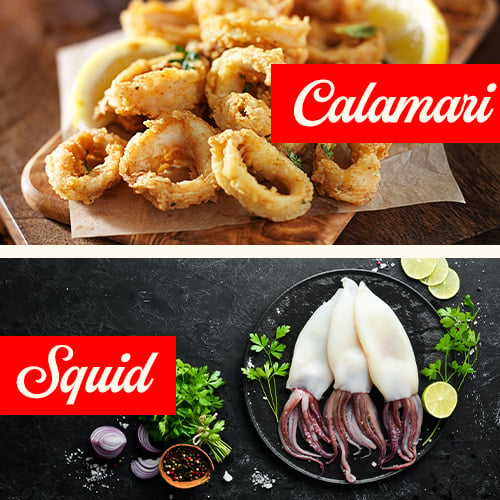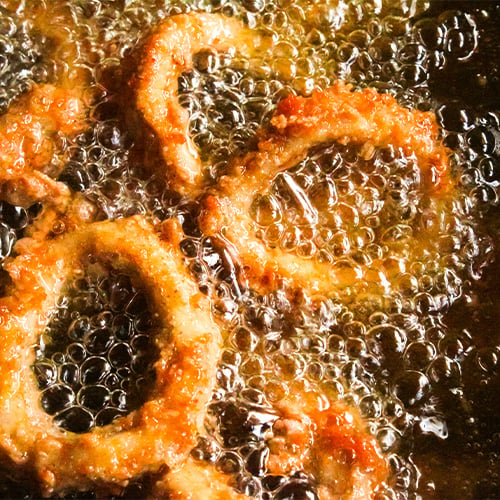Calamari is a popular seafood choice for restaurants. This versatile mollusk is widely available and can be purchased fresh, frozen, or pre-prepared, making it a convenient option for establishments of all sizes. Learn more about this affordable and adaptable protein so you can add a delicious yet budget-friendly seafood dish to your menu.
Shop All CalamariWhat Is Calamari?

Calamari, pronounced kaa-laa-maa-ree, is the meat of squid. This mollusk is known for its tender texture and mild, slightly sweet flavor. It is typically prepared by cleaning and cutting the squid into rings or strips before cooking. The most common cooking methods for calamari include frying, grilling, and sauteing.
Due to its mild taste, calamari pairs well with a wide range of seasonings and sauces, making it an adaptable ingredient in commercial kitchens. In addition to its delicious taste and versatility in the kitchen, calamari is also a nutritious choice for consumers. It is a good source of protein, low in fat, and provides essential nutrients, making it a flavorful and healthy seafood dish.
What Does Calamari Taste Like?
Calamari has a mild and slightly sweet flavor with a firm and chewy texture. When cooked properly, calamari should be tender and succulent, not tough or rubbery. The taste of calamari is often described as similar to scallops and shrimp. The flavor and mouthfeel of calamari depend on how it is prepared. When fried, calamari takes on a crispy exterior while remaining tender on the inside, with a slightly salty and savory taste. Grilled calamari offers a smoky flavor that complements the natural sweetness of the seafood.
Calamari vs Squid

The term calamari is commonly used to make the dish sound more appealing and exotic on menus, but calamari and squid are the same thing. In culinary terms, calamari is the Italian word for squid. When people refer to calamari in America, they are typically talking about calamari fritti, which is a popular dish of deep-fried squid rings. When preparing calamari, the mantle of the squid is the primary part used. The mantle is a muscular sac that surrounds the squid's internal organs, providing a meaty and flavorful component to the dish.
Is Calamari Squid or Octopus?
Calamari is made from squid, not octopus. Squid and octopus are both cephalopods, marine mollusks with tentacles, but they belong to different families and have unique characteristics. A squid has a long, tubular body with a distinct head and a total of 10 appendages, consisting of eight arms and two tentacles that are longer than the arms. It is known for its firm texture and mild, slightly sweet flavor. An octopus has a round head and a soft, gelatinous body with eight tentacles. It has a chewier texture compared to squid and a more pronounced seafood flavor.
Where Does Calamari Come From?
Calamari is harvested from various species of squid. These marine creatures are found in oceans and seas worldwide, with some of the largest squid populations inhabiting the Mediterranean Sea, North Atlantic Ocean, and the Pacific Ocean. The most commonly used species for calamari are the European squid (Loligo vulgaris), the North Atlantic squid (Illex illecebrosus), and the Pacific flying squid (Todarodes pacificus). These squid species are known for their tender meat and mild flavor, making them ideal for a variety of culinary preparations.
Squids are highly adaptable and can thrive in a wide range of oceanic environments, making them a common catch for commercial fishing operations. Businesses must be mindful of the sources from which they procure calamari. Overfishing and destructive fishing practices can deplete squid populations and harm marine ecosystems. To promote sustainable seafood practices, businesses should prioritize sourcing calamari from suppliers who follow responsible fishing methods and support initiatives aimed at preserving marine biodiversity.
Is Calamari Italian?
The word "calamari" itself is Italian, derived from the Latin word "calamarium," meaning ink pot. This name was given to the dish due to the squid's ink sac, which can be used for culinary purposes. Despite its Italian name, calamari is a dish that is enjoyed in various cultures and cuisines. In Mediterranean countries such as Spain and Greece, calamari is a common seafood delicacy. The Greeks have been known to stuff calamari with a mixture of rice, herbs, and spices before cooking it. In Italy, calamari fritti is a popular appetizer. It is made by coating squid in a light batter, frying it to perfection, and serving it with marinara dipping sauce. Calamari is also a popular ingredient in Italian pasta dishes, adding a unique texture and flavor to classic recipes.
How to Cook Squid

Squid, also known as calamari, can be prepared using multiple cooking methods to create delicious dishes for your commercial kitchen. We've outlined the most popular ways to cook squid and a brief explanation of how to execute each below:
- Grilling: Preheat the grill to medium-high heat and cook the squid for 2-3 minutes per side until it is opaque and slightly charred.
- Frying: Coat the squid in a light batter or breading and fry in hot oil for 2-3 minutes until golden brown and crispy.
- Sauteing: Heat oil or butter in a pan over medium-high heat and cook the squid for 2-3 minutes until it is tender and opaque.
- Boiling: Bring a pot of salted water to a boil and cook the squid for 1-2 minutes until it turns opaque and curls up.
Best Oil to Fry Calamari
Your choice of oil for frying seafood determines the crispiness and flavor of the final dish. Consider the smoke point, flavor profile, and health benefits of the cooking oils to create a delicious and crispy calamari dish for your commercial kitchen. Here are some of the best oils to consider when frying calamari:
- Vegetable Oil: Vegetable oil is a popular choice for frying calamari due to its neutral flavor and high smoke point. It is versatile and can be used for deep frying at high temperatures without burning, resulting in a crispy exterior while keeping the calamari tender on the inside.
- Canola Oil: Canola oil has a mild flavor, a high smoke point, and is low in saturated fats, making it a healthier choice for deep frying. It also helps maintain the natural flavors of the calamari without overpowering them.
- Peanut Oil: Peanut oil is known for its high smoke point and nutty flavor, which can add a unique taste to fried calamari. It is ideal for deep frying as it can withstand high temperatures without breaking down, resulting in a crispy and delicious coating on the calamari.
- Corn Oil: Corn oil is a budget-friendly option for frying calamari. Its mild flavor and high smoke point make it suitable for deep frying. Corn oil helps to achieve a golden-brown crust on the calamari while preserving its natural taste and texture.
- Olive Oil: While not used for deep frying due to its lower smoke point, olive oil can still be used to fry calamari at moderate temperatures. Extra virgin olive oil adds a distinct flavor to the dish, enhancing the overall taste of the calamari.
- Sunflower Oil: Sunflower oil has a neutral flavor, a high smoke point, and is rich in vitamin E, making it a healthy choice for deep frying. It helps to create a crispy and light coating on the calamari while retaining its moisture.
Calamari Dishes

Calamari is a popular seafood delicacy featured in a variety of international dishes. From crispy fried calamari to flavorful stir-fried calamari, these international calamari dishes offer a glimpse into the diverse culinary traditions that celebrate the unique flavor and texture of calamari around the world.
- Fritto Misto: This Italian dish features a mix of fried seafood, including calamari rings, shrimp, and fish, coated in a light and crispy batter. Fritto misto is often served with lemon wedges and a side of marinara sauce for dipping.
- Calamari Salad: In Greece, calamari is often marinated in a mixture of olive oil, lemon juice, garlic, and herbs before being grilled or sauteed. The tender calamari is then served on a bed of fresh greens, tomatoes, and olives for a refreshing and flavorful salad.
- Salt and Pepper Calamari: A popular dish in Chinese cuisine, salt and pepper calamari features tender calamari pieces seasoned with a blend of salt, white pepper, and Chinese five-spice powder. The calamari is typically stir-fried with garlic, chili peppers, and scallions for a spicy and aromatic flavor profile.
- Stuffed Calamari: In Mediterranean cuisine, calamari tubes are often stuffed with a flavorful mixture of ingredients such as rice, herbs, tomatoes, and pine nuts before being simmered in a rich tomato sauce. Stuffed calamari is a hearty and satisfying dish that is popular throughout Italy, Greece, Portugal, Spain, and Turkey.
- Calamari Tempura: Tempura-battered calamari is a popular dish in Japanese cuisine, where the calamari rings are coated in a light and crispy batter made from flour, cornstarch, and ice-cold water before being deep-fried to perfection. It's typically served with an Asian dipping sauce such as tentsuyu or ponzu.
- Calamari Tacos: In Mexican cuisine, calamari is often grilled or sauteed and served in warm corn tortillas with a variety of toppings such as salsa, avocado, and lime crema. Calamari tacos offer a delicious fusion of flavors and textures that are sure to tantalize the taste buds.
Whether you run a seafood restaurant, a bar serving appetizers, or a catering business, incorporating calamari into your menu can attract a wide range of customers. From classic fried calamari to grilled calamari salads, the options are endless. By understanding the best cooking methods and flavor pairings, you can elevate your menu offerings and satisfy your customers' cravings for this beloved seafood delicacy.








